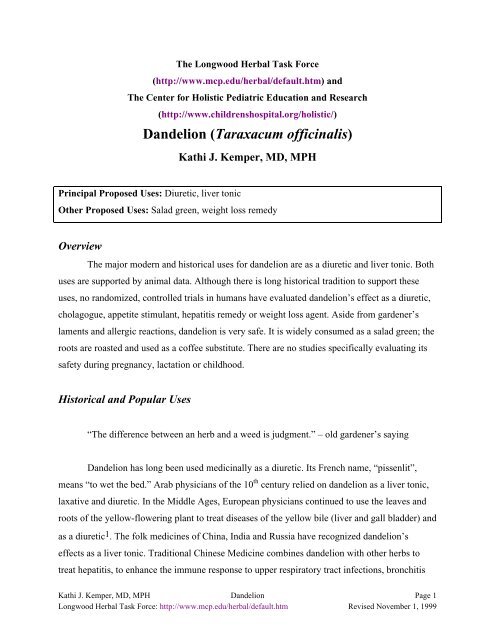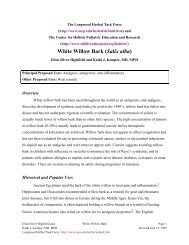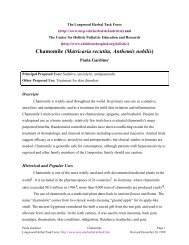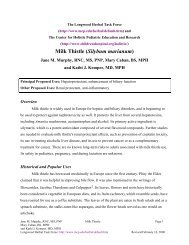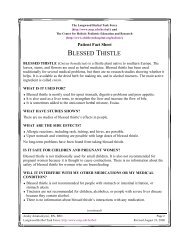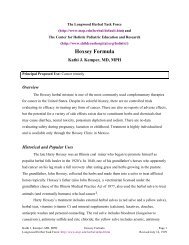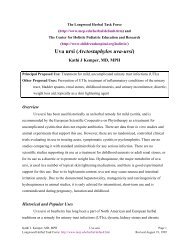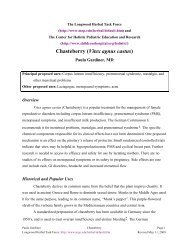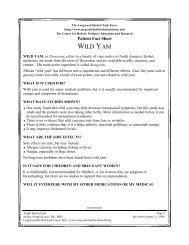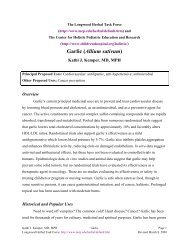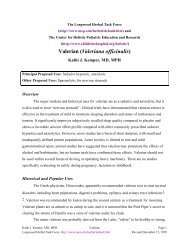Dandelion (Taraxacum officinalis) - Longwood Herbal Task Force
Dandelion (Taraxacum officinalis) - Longwood Herbal Task Force
Dandelion (Taraxacum officinalis) - Longwood Herbal Task Force
Create successful ePaper yourself
Turn your PDF publications into a flip-book with our unique Google optimized e-Paper software.
The <strong>Longwood</strong> <strong>Herbal</strong> <strong>Task</strong> <strong>Force</strong><br />
(http://www.mcp.edu/herbal/default.htm) and<br />
The Center for Holistic Pediatric Education and Research<br />
(http://www.childrenshospital.org/holistic/)<br />
<strong>Dandelion</strong> (<strong>Taraxacum</strong> <strong>officinalis</strong>)<br />
Principal Proposed Uses: Diuretic, liver tonic<br />
Kathi J. Kemper, MD, MPH<br />
Other Proposed Uses: Salad green, weight loss remedy<br />
Overview<br />
The major modern and historical uses for dandelion are as a diuretic and liver tonic. Both<br />
uses are supported by animal data. Although there is long historical tradition to support these<br />
uses, no randomized, controlled trials in humans have evaluated dandelion’s effect as a diuretic,<br />
cholagogue, appetite stimulant, hepatitis remedy or weight loss agent. Aside from gardener’s<br />
laments and allergic reactions, dandelion is very safe. It is widely consumed as a salad green; the<br />
roots are roasted and used as a coffee substitute. There are no studies specifically evaluating its<br />
safety during pregnancy, lactation or childhood.<br />
Historical and Popular Uses<br />
“The difference between an herb and a weed is judgment.” – old gardener’s saying<br />
<strong>Dandelion</strong> has long been used medicinally as a diuretic. Its French name, “pissenlit”,<br />
means “to wet the bed.” Arab physicians of the 10 th century relied on dandelion as a liver tonic,<br />
laxative and diuretic. In the Middle Ages, European physicians continued to use the leaves and<br />
roots of the yellow-flowering plant to treat diseases of the yellow bile (liver and gall bladder) and<br />
as a diuretic 1 . The folk medicines of China, India and Russia have recognized dandelion’s<br />
effects as a liver tonic. Traditional Chinese Medicine combines dandelion with other herbs to<br />
treat hepatitis, to enhance the immune response to upper respiratory tract infections, bronchitis<br />
Kathi J. Kemper, MD, MPH <strong>Dandelion</strong> Page 1<br />
<strong>Longwood</strong> <strong>Herbal</strong> <strong>Task</strong> <strong>Force</strong>: http://www.mcp.edu/herbal/default.htm Revised November 1, 1999
and pneumonia, and as a topical compress to treat mastitis. As recently as 1957, more than 20<br />
tons of dandelion leaves were imported into the US annually for medicinal purposes 2 .<br />
<strong>Dandelion</strong> was included as a diuretic in the US pharmacopeia from 1831 to 1926 3 . Based<br />
on its diuretic effects, dandelion is often included in herbal weight loss and premenstrual<br />
syndrome remedies. Some herbalists also recommend it as a way to help prevent<br />
atherosclerosis 4 . Others suggest it may be a useful spring and fall tonic for patients with chronic<br />
osteoarthritis and those with a tendency to form gallstones 5 .<br />
In addition to its medicinal uses, dandelion serves as a salad green in the gourmet’s<br />
garden and as an unwelcome weed in the well-manicured lawn. The leaves are an excellent<br />
source of vitamin A. The ground roots are sometimes used as a substitute for chicory roots or<br />
coffee beans. The flowers are sometimes fermented into wine. The root is the part most often<br />
used medicinally 2 . The German Commission E approves it for use as a diuretic and to treat<br />
dyspepsia, liver and gallbladder complaints and appetite loss 6, 7 .<br />
Botany<br />
Medicinal species: <strong>Taraxacum</strong> <strong>officinalis</strong> aka Leontodon taraxacum (roots are Radix taraxaci;<br />
leaves are Herba taraxaci). Europeans have developed over 100 specialized varieties for<br />
salads, cooking, wine, and as a coffee substitute.<br />
Common names: Blowball, canker wart, fairy clock, lion’s tooth, piss-in-bed, white endive, wild<br />
endive; Lowenzahnwurzel (Ger); pissenlit (Fr); pu gong ying (Ch) 3, 8<br />
Botanical family: Compositae, sub-family Cichoroideae (chicory)<br />
Plant description: <strong>Dandelion</strong> is known as a self-sowing, variable perennial – also known as a<br />
weed. The dentate leaves grow close to the ground in a rosette around the hollow stem.<br />
The tap root extends several inches into the ground. The yellow flowers are sensitive to<br />
light, opening in bright sunlight and closing during dark and dreary days; they bloom<br />
throughout the summer and becomes “fuzzball”, full of feathery seeds.<br />
Where it’s grown: <strong>Dandelion</strong> was originally native to Europe and Asia, but made a successful<br />
transition across the Atlantic ocean; it now grows amazingly well in yards, gardens,<br />
fields, roadsides, open meadows and waste ground.<br />
Kathi J. Kemper, MD, MPH <strong>Dandelion</strong> Page 2<br />
<strong>Longwood</strong> <strong>Herbal</strong> <strong>Task</strong> <strong>Force</strong>: http://www.mcp.edu/herbal/default.htm Revised November 1, 1999
Biochemistry<br />
<strong>Dandelion</strong>: Potentially Active Chemical Constituents<br />
• Sesquiterpene lactones (bitters): taraxinic acid (taraxacin), tetrahydroridentin B<br />
• Triterpenoids and sterols: taraxasterol, taraxerol, cycloartenol, beta-sitosterol<br />
• Other: Vitamin A, Vitamin C, tannins, alkaloids, pectin, inulin, starch, potassium, beta<br />
carotene, caffeic acid, flavonoids (apigenin)<br />
<strong>Dandelion</strong>’s active ingredients are found in both the roots and leaves. The leaves contain<br />
bitter sesquiterpene lactones such as taraxinic acid and triterpenoids such as cycloartenol. The<br />
roots contain these compounds as well as phenolic acids and inulin 9, 10 . Potassium is present in<br />
the leaves at 297 mg per 100 grams of leaves 11 . The leaves also contain substantial amounts of<br />
Vitamin A (14,000 units per 100 grams of leaves, compared with 11,000 units per 100 grams of<br />
carrots) 11 .<br />
The sesquiterpene lactones found in both leaves and root have demonstrated diuretic<br />
effects 12 . They also stimulate bile flow from the liver.<br />
Different compounds may be present in different products depending on extraction<br />
methods. For example, the alcoholic extracts stimulate bile excretion whereas the aqueous<br />
extracts have no such effects.<br />
Kathi J. Kemper, MD, MPH <strong>Dandelion</strong> Page 3<br />
<strong>Longwood</strong> <strong>Herbal</strong> <strong>Task</strong> <strong>Force</strong>: http://www.mcp.edu/herbal/default.htm Revised November 1, 1999
Experimental Studies<br />
1. Cardiovascular: none<br />
2. Pulmonary: none<br />
3. Renal and electrolyte balance: Diuretic<br />
<strong>Dandelion</strong>: Potential Clinical Benefits<br />
4. Gastrointestinal/hepatic: Cholagogue, digestive aid and appetite stimulant, laxative, hepatitis<br />
5. Neuro-psychiatric: none<br />
6. Endocrine: Diabetes<br />
7. Hematologic: none<br />
8. Rheumatologic: none<br />
9. Reproductive: none<br />
10. Immune modulation: Immunostimulant<br />
11. Antimicrobial: Antiviral<br />
12. Antineoplastic: Antitumor<br />
13. Antioxidant: none<br />
14. Skin and mucus membranes: Wart remedy<br />
15. Other/miscellaneous: none<br />
1. Cardiovascular: none<br />
2. Pulmonary: none<br />
3. Renal and electrolyte balance: Diuretic<br />
i. In vitro data: none<br />
ii. Animal data: In rats and mice, dandelion leaf extracts had diuretic effects as potent as<br />
furosemide 12 . It has greater diuretic effects than other herbs such as equisetum and<br />
juniper berry 11, 13 . The diuretic effect accounted for 100% of the weight loss found in<br />
these animal studies.<br />
iii. Human data: There are no studies evaluating the diuretic effects of dandelion leaves or<br />
roots in humans or comparing it to standard diuretic medications.<br />
Kathi J. Kemper, MD, MPH <strong>Dandelion</strong> Page 4<br />
<strong>Longwood</strong> <strong>Herbal</strong> <strong>Task</strong> <strong>Force</strong>: http://www.mcp.edu/herbal/default.htm Revised November 1, 1999
4. Gastrointestinal/hepatic: Cholagogue, digestive aid and appetite stimulant, laxative,<br />
treatment of hepatitis B<br />
a. Cholagogue: <strong>Dandelion</strong> has long been used to stimulate bile secretion 14 .<br />
i. In vitro data: none<br />
ii. Animal data: In German studies, dandelion leaf extracts increased bile secretion by<br />
40% in rats 15 . In French studies, giving dogs a decoction of fresh dandelion root<br />
doubled their bile output 16 .<br />
iii. Human data: There are no studies in humans evaluating dandelion’s effect on bile<br />
production or excretion.<br />
c. Digestive aid and appetite stimulant: Historically, plants with strong bitter flavors have<br />
been regarded as digestion and appetite enhancers.<br />
i. In vitro data: none<br />
ii. Animal data: In two Chinese studies of animals with gastric ulcers, gastric metaplasia<br />
and hyperplasia, dandelion-containing herbal combinations led to significant<br />
histologic improvement (based on English abstracts) 17, 18 .<br />
iii. Human data: none<br />
d. Laxative: <strong>Dandelion</strong>’s historical use as a gentle laxative has not been thoroughly<br />
evaluated in modern studies 19 . In a case series of 24 adults suffering from chronic colitis,<br />
an herbal combination containing dandelion improved constipation, diarrhea and<br />
intestinal cramping in 96% of patients 20 .<br />
e. Treatment of hepatitis B: The Chinese have relied on an herbal combination including<br />
dandelion in the treatment of hepatitis B infections. A Chinese case series reported that<br />
an herbal combination including dandelion was helpful in treating 96 adults with chronic<br />
hepatitis B infection 21 . There are no in vitro or animal data to evaluate this use.<br />
5. Neuropsychiatric: none<br />
6. Endocrine: Diabetes: <strong>Dandelion</strong> is a traditional European remedy for Type II diabetes.<br />
i. In vitro data: none<br />
ii. Animal data: <strong>Dandelion</strong> roots in doses of 500 mg per kg body weight exerted moderate<br />
hypoglycemic effects in normal rabbits, but not those with experimentally induced<br />
Kathi J. Kemper, MD, MPH <strong>Dandelion</strong> Page 5<br />
<strong>Longwood</strong> <strong>Herbal</strong> <strong>Task</strong> <strong>Force</strong>: http://www.mcp.edu/herbal/default.htm Revised November 1, 1999
diabetes 22 . In both normal mice and those with experimentally-induced diabetes,<br />
dandelion extracts exerted no significant effect on blood sugar levels 23 .<br />
iii. Human data: There are no studies evaluating the effects of dandelion preparations on<br />
blood sugar levels in normal or diabetic humans.<br />
7. Hematologic: none<br />
8. Rheumatologic: none<br />
9. Reproductive: none<br />
10. Immune modulation: Immunostimulant<br />
i. In vitro data: none<br />
ii. Animal data: In Chinese studies of mice with immunosuppression secondary to scald<br />
burns, dandelion and five other herbs enhanced several measures of immune<br />
functioning 24 .<br />
iii. Human data: none<br />
11. Antimicrobial: Antiviral<br />
i. In vitro data: Like many herbal extracts, dandelion demonstrated antiviral effects against<br />
human herpes virus, type 1 (HHV1) in vitro 25 .<br />
ii. Animal data: none<br />
iii. Human data: none<br />
12. Antineoplastic: Antitumor<br />
i. In vitro data: Like many herbal extracts, dandelion has demonstrated antitumor effects in<br />
vitro 26, 27 .<br />
ii. Animal data: none<br />
iii. Human data: none<br />
13. Antioxidant: none<br />
14. Skin and mucus membranes: Wart remedy. Direct application of dandelion juice to the<br />
lesion is a popular wart remedy which has not undergone thorough scientific evaluation, but<br />
is probably as safe and effective as most other home remedies for warts 1 .<br />
16. Other/miscellaneous: none<br />
Kathi J. Kemper, MD, MPH <strong>Dandelion</strong> Page 6<br />
<strong>Longwood</strong> <strong>Herbal</strong> <strong>Task</strong> <strong>Force</strong>: http://www.mcp.edu/herbal/default.htm Revised November 1, 1999
Toxicity and Contraindications<br />
All herbal products carry the potential for contamination with other herbal products, pesticides,<br />
herbicides, heavy metals, and pharmaceuticals.<br />
This is particularly concerning for imports from developing countries.<br />
Furthermore, allergic reactions can occur to any natural product in sensitive persons<br />
Allergic reactions and contact dermatitis to dandelion have been reported; taraxinic acid appears<br />
to be the most allergenic component of the plant 28-37 .<br />
Potentially toxic compounds in dandelion: None<br />
Acute toxicity: Aside from acute allergic reactions, no acute toxicity has been observed. Doses of<br />
up to 6 grams per kg body weight administered daily for seven days to rabbits did not<br />
result in measurable toxicity 22 .<br />
Chronic: None reported. Carcinogenesis was not observed in rats whose diet contained up to<br />
33% dandelion for several months 38 . <strong>Dandelion</strong> is one of several vegetables that<br />
demonstrate antimutagenic effects 39 .<br />
Limitations during other illnesses or in patients with specific organ dysfunction: Unknown;<br />
herbalists traditionally recommend that dandelion be avoided by patients with biliary<br />
occlusion, acute cholecystitis and ileus 9, 40 .<br />
Interactions with other herbs or pharmaceuticals: Unknown; none reported. Some herbalists<br />
recommend avoiding the combination of dandelion and diuretic medications, but no<br />
adverse effects from this combination have been reported 11 .<br />
Safety during pregnancy, lactation and/or childhood: Unknown. No adverse effects have been<br />
reported when taken in doses usually consumed as food.<br />
Kathi J. Kemper, MD, MPH <strong>Dandelion</strong> Page 7<br />
<strong>Longwood</strong> <strong>Herbal</strong> <strong>Task</strong> <strong>Force</strong>: http://www.mcp.edu/herbal/default.htm Revised November 1, 1999
Typical Dosages<br />
Provision of dosage information dose NOT constitute a recommendation or endorsement, but<br />
rather indicates the range of doses commonly used in herbal practice.<br />
Doses are given for single herb use and must be adjusted when using herbs in combinations.<br />
Doses may also vary according to the type and severity of the condition treated and individual<br />
patient conditions.<br />
Adult doses: There is disagreement on the optimal form and dose of dandelion. Reputable<br />
physicians and herbalists recommend a range of doses 4, 9, 11 :<br />
Fresh leaves: 4-10 grams daily<br />
Dried leaves: 4-10 grams daily<br />
Fresh leaf juice: 1 tsp (4-8 ml) twice daily<br />
Fluid extract: 1-2 teaspoons daily<br />
Fresh roots: 2-8 grams daily<br />
Dried powdered extract: 250-1000 mg three to four times daily<br />
Tea: Pour 2 cups boiling water over one ounce of fresh leaves and steep for 10 minutes.<br />
Pediatric dosages: Unknown<br />
Or, boil 1 cup of water with 2-3 tsp of dried, cut root for 15 minutes. Cool.<br />
Availability of standardized preparations: None<br />
Dosages used in herbal combinations: Variable<br />
Proprietary names: Cholaktol TR, Galleb S, Justogen mono, Kneipp Lowenzahn-Pflanzensaft,<br />
Taraleon<br />
Multi-ingredient preparations containing dandelion: Agnuchol, Agrimonas, Aristochol N,<br />
See Also:<br />
Berberis complex, Bio-Garten Tee, Chol-Grandelat, Cholongal, Cholosom, Fluid Loss,<br />
Galleb forte, Gallexier, Hepafungin, Helalixier, <strong>Herbal</strong> diuretic complex, Phytomed<br />
Hepato, Stomach mixture, Uva ursi complex, Uvacin, Waterlex<br />
<strong>Dandelion</strong> Clinician Information Summary:<br />
http://www.mcp.edu/herbal/dandelion/dandelion.cis.pdf<br />
<strong>Dandelion</strong> Patient Fact Sheet: http://www.mcp.edu/herbal/dandelion/dandelion.ph.pdf<br />
Kathi J. Kemper, MD, MPH <strong>Dandelion</strong> Page 8<br />
<strong>Longwood</strong> <strong>Herbal</strong> <strong>Task</strong> <strong>Force</strong>: http://www.mcp.edu/herbal/default.htm Revised November 1, 1999
REFERENCES<br />
1. Lewis WH. Medical botany : plants affecting man's health. New York: Wiley, 1977.<br />
2. Duke JA. CRC handbook of medicinal herbs. Boca Raton: CRC Press, 1985.<br />
3. Peirce A. The American Pharmaceutical Association practical guide to natural medicines. New York: William Morrow<br />
and Company, Inc., 1999.<br />
4. Ottariano SG. Medicinal herbal therapy : a pharmacist's view. Portsmouth, NH: Nicoln Fields Pub., 1999.<br />
5. Weiss RF. <strong>Herbal</strong> medicine. Gothenburg, Sweden: AB Arcanum, 1988.<br />
6. Blumenthal M. The complete German Commission E monographs : therapeutic guide to herbal medicines. Austin:<br />
American Botanical Council, 1998.<br />
7. Fleming T. PDR for herbal medicines. Montvale, NJ: Medical Economics Company, Inc., 1998.<br />
8. Huang KC. The pharmacology of Chinese herbs. Boca Raton: CRC Press, 1999.<br />
9. Bradley PR. British herbal compendium : a handbook of scientific information on widely used plant drugs / published<br />
by the British <strong>Herbal</strong> Medicine Association and produced by its Scientific Committee. Bournemouth, Dorset: The<br />
Association, 1992.<br />
10. Hansel R, Kartarahardja M, Huang J, Bohlmann F. Sesquiterpene lactone-beta-D-glucopyranosidee sowie ein neues<br />
Eudesmanolid aus <strong>Taraxacum</strong> officinale. Phytochemistry 1980; 19:857-61.<br />
11. Newall CA, Anderson LA, Phillipson JD. <strong>Herbal</strong> medicines : a guide for health-care professionals. London:<br />
Pharmaceutical Press, 1996:ix, 296.<br />
12. Racz-Kotilla E, Racz G, Solomon A. The action of <strong>Taraxacum</strong> officinale extracts on the body weight and diuresis of<br />
laboratory animals. Planta Med 1974; 26:212-7.<br />
13. Bissett NG. <strong>Herbal</strong> Drugs and Phytopharmaceuticals. Stuttgart: MedPharm CRC Press, 1994:566.<br />
14. Chabrot E, Charonnat R. Therpeutic agents in bile secretion. Ann Med 1935; 9:1463-67.<br />
15. Bohm K. Studies on the choleretic action of some drugs. Arzneim-Forsch 1959; 9:376-78.<br />
16. Chabrol E, Charonnat R, Maximin M, Waitz R, Porin J. L'action choleretique des Composees. C R Soc Biol 1931;<br />
108:1100-2.<br />
17. Liu X, Han W, Sun D. Treatment of intestinal metaplasia and atypical hyperplasia of gastric mucosa with xiao wei yan<br />
powder. Chung Kuo Chung Hsi Chieh Ho Tsa Chih 1992; 12:602-3.<br />
18. Fang J. Effect of fu-zheng qu-xie on gastric disease infected with Campylobacter pyloridis. Chin J Mod Dev Trad Med<br />
1991; 11:150-2, 133.<br />
19. Tyler VE. The new honest herbal : a sensible guide to the use of herbs and related remedies. Philadelphia, Pa.: G.F.<br />
Stickley Co., 1987:xii, 254.<br />
Kathi J. Kemper, MD, MPH <strong>Dandelion</strong> Page 9<br />
<strong>Longwood</strong> <strong>Herbal</strong> <strong>Task</strong> <strong>Force</strong>: http://www.mcp.edu/herbal/default.htm Revised November 1, 1999
20. Chakurski I, Matev M, Koichev A, Angelova I, Stefanov G. Treatment of chronic colitis with an herbal combination of<br />
<strong>Taraxacum</strong> officinale, Hipericum perforatum, Melissa <strong>officinalis</strong>s, Calendula <strong>officinalis</strong> and Foeniculum vulgare. Vutr<br />
Boles 1981; 20:51-4.<br />
21. Chen Z. Clinical study of 96 cases with chronic hepatitis B treated with jiedu yanggan gao by a double-blind method.<br />
Chin J Mod Dev Trad Med 1990; 10:71-4.<br />
22. Akhtar MS, Khan QM, Khaliq T. Effects of Portulaca oleracae (Kulfa) and <strong>Taraxacum</strong> officinale (Dhudhal) in<br />
normoglycaemic and alloxan-treated hyperglycaemic rabbits. JPMA J Pak Med Assoc 1985; 35:207-10.<br />
23. Swanston-Flatt SK, Day C, Flatt PR, Gould BJ, Bailey CJ. Glycaemic effects of traditional European plant treatments<br />
for diabetes. Studies in normal and streptozotocin diabetic mice. Diabetes Res 1989; 10:69-73.<br />
24. Luo ZH. The use of Chinese traditional medicines to improve impaired immune functions in scald mice. Chung Hua<br />
Cheng Hsing Shao Shang Wai Ko Tsa Chih 1993; 9:56-8, 80.<br />
25. Zheng M. Experimental study of 472 herbs with antiviral action against herpes simplex virus. Chin J Mod Dev Trad<br />
Med 1990; 10.<br />
26. Baba K, Abe S, Mizuno D. Antitumor activity of hot water extract of dandelion, <strong>Taraxacum</strong> officinale-correlation<br />
between antitumor activity and timing of administration. Yakugaku Zasshi 1981; 101:538-43.<br />
27. Sieyaku K. <strong>Taraxacum</strong> extracts as anti-tumor agents. Chem Abstr 1981; 94:374.<br />
28. Cohen SH, Yunginger JW, Rosenberg N, Fink JN. Acute allergic reaction after composite pollen ingestion. J Allergy<br />
Clin Immunol 1979; 64:270-4.<br />
29. Davies MG, Kersey PJ. Contact allergy to yarrow and dandelion. Contact Dermatitis 1986; 14:256-7.<br />
30. Dawe RS, Green CM, MacLeod TM, Ferguson J. Daisy, dandelion and thistle contact allergy in the photosensitivity<br />
dermatitis and actinic reticuloid syndrome. Contact Dermatitis 1996; 35:109-10.<br />
31. Fernandez C, Martin-Esteban M, Fiandor A, Pascual C, Lopez Serrano C, Martinez Alzamora F, et al. Analysis of<br />
cross-reactivity between sunflower pollen and other pollens of the Compositae family. J Allergy Clin Immunol 1993;<br />
92:660-7.<br />
32. Goulden V, Wilkinson SM. Patch testing for Compositae allergy. Br J Dermatol 1998; 138:1018-21.<br />
33. Guin JD, Skidmore G. Compositae dermatitis in childhood. Arch Dermatol 1987; 123:500-2.<br />
34. Hausen BM. Taraxinic acid 1'-O-beta-D-glucopyranoside, the contact sensitizer of dandelion (<strong>Taraxacum</strong> officinale<br />
Wiggers). Derm Beruf Umwelt 1982; 30:51-3.<br />
35. Lovell CR, Rowan M. <strong>Dandelion</strong> dermatitis. Contact Dermatitis 1991; 25:185-8.<br />
36. Wakelin SH, Marren P, Young E, Shaw S. Compositae sensitivity and chronic hand dermatitis in a seven-year-old boy.<br />
Br J Dermatol 1997; 137:289-91.<br />
37. Zeller W, de Gols M, Hausen BM. The sensitizing capacity of Compositae plants. VI. Guinea pig sensitization<br />
experiments with ornamental plants and weeds using different methods. Arch Dermatol Res 1985; 277:28-35.<br />
38. Hirono I, Mori H, Kato K, Ushimaru Y, Kato T, Haga M. Safety examination of some edible plants, Part 2. J Environ<br />
Pathol Toxicol 1978; 1:71-4.<br />
Kathi J. Kemper, MD, MPH <strong>Dandelion</strong> Page 10<br />
<strong>Longwood</strong> <strong>Herbal</strong> <strong>Task</strong> <strong>Force</strong>: http://www.mcp.edu/herbal/default.htm Revised November 1, 1999
39. Lai C, Butler M, Matney T. Antimutagenic activities of common vegetables and their chlorophyll content. Mutation<br />
Research 1980; 77:245-50.<br />
40. McGuffin M, Hobbs C, Upton R, Goldberg A. American <strong>Herbal</strong> Products Association's Botanical Safety Handbook.<br />
Boca Raton. New York: CRC Press, 1997:231.<br />
Kathi J. Kemper, MD, MPH <strong>Dandelion</strong> Page 11<br />
<strong>Longwood</strong> <strong>Herbal</strong> <strong>Task</strong> <strong>Force</strong>: http://www.mcp.edu/herbal/default.htm Revised November 1, 1999


